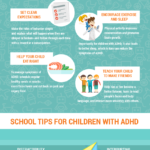ADHD and your child

Download ADHD and your child Infographic
Disability Credit Canada mission is to help disabled Canadians qualify for Disability Tax Credit & CPP Disability Benefits and then maximize their tax refunds & credits. We’ve worked with thousands of Disabled Canadians suffering from mental disabilities and we recognize how impactful your condition can be on you and your family, hence we regular advocate for rights of Disabled Canadians.
ADD/ADHD is a condition affecting both children and adults; estimates suggesting approximately 300,000 or more Canadians are diagnosed each year. Both diseases cause disabling symptoms that impede development and impair social function. ADHD is a mental disorder that interferes with the learning process, impedes social and cognitive development, and can be a precursor to a variety of other conditions.
In the infographic below, we give you some useful tips and tricks for parents as well as teachers in order to better understand how to manage children with ADHD.

Parenting Tips for children with ADHD:
- Take care of yourself so you’re better able to care for your child. Eat right, exercise, get enough sleep, find ways to reduce stress, and seek face-to-face support from family and friends as well as your child’s doctor and teachers.
- Establish structure and stick to it. Help your child stay focused and organized by following daily routines, simplifying your child’s schedule, and keeping your child busy with healthy activities.
- Set clear expectations. Make the rules of behavior simple and explain what will happen when they are obeyed or broken—and follow through each time with a reward or a consequence.
- Encourage exercise and sleep. Physical activity improves concentration and promotes brain growth. Importantly for children with ADHD, it also leads to better sleep, which in turn can reduce the symptoms of ADHD.
- Help your child eat right. To manage symptoms of ADHD, schedule regular healthy meals or snacks every three hours and cut back on junk and sugary food.
Teach your child how to make friends. Help him or her become a better listener, learn to read people’s faces and body language, and interact more smoothly with others.
School tips for children with ADHD:
Symptom |
Tip |
| Distractibility | Seat the child away from doors and windows. Alternate seated activities with those that allow the child to move around. Divide big assignments into smaller ones and allow frequent breaks. |
| Interrupting | Use discreet gestures or words you have previously agreed upon to let the child know they are interrupting. Praise the child for interruption-free conversations. |
| Impulsivity | Tape a written behavior plan to the wall or the child’s desk. Give consequences immediately following misbehavior and recognize good behavior out loud. |
| Fidgeting and hyperactivity | Finding creative ways to allow the child to move in appropriate ways at appropriate times can make it easier for the child to keep still during work time. Provide a stress ball, encourage exercise before and after school, and ask the child to run errands in the classroom. |
| Trouble following directions | Break down and reinforce the steps involved in your instructions. Allow the child to do one step and then come back to find out what they should do next. If the child gets off track, give a calm reminder. Write directions on a board. |
| General inattentiveness Make learning fun | Using physical motion in a lesson, connecting dry facts to interesting trivia, or inventing silly songs that make details easier to remember can help a child enjoy learning and even reduce the symptoms of ADHD |
Share this Image On Your Site. Just copy and paste the code below. Please make sure to include attribution to Disability Credit Canada!
Would you like to share this infographic on your website? Just copy and paste the code provided below! Please include attribution to Disability Credit Canada!
At Disability Credit Canada, we take pride in helping disabled Canadians claim disability tax credit.
- 2017 ADHD Infographic – Myths &Facts [Infographic]
- Disability in Canada: A Complete Profile [Infographic]

